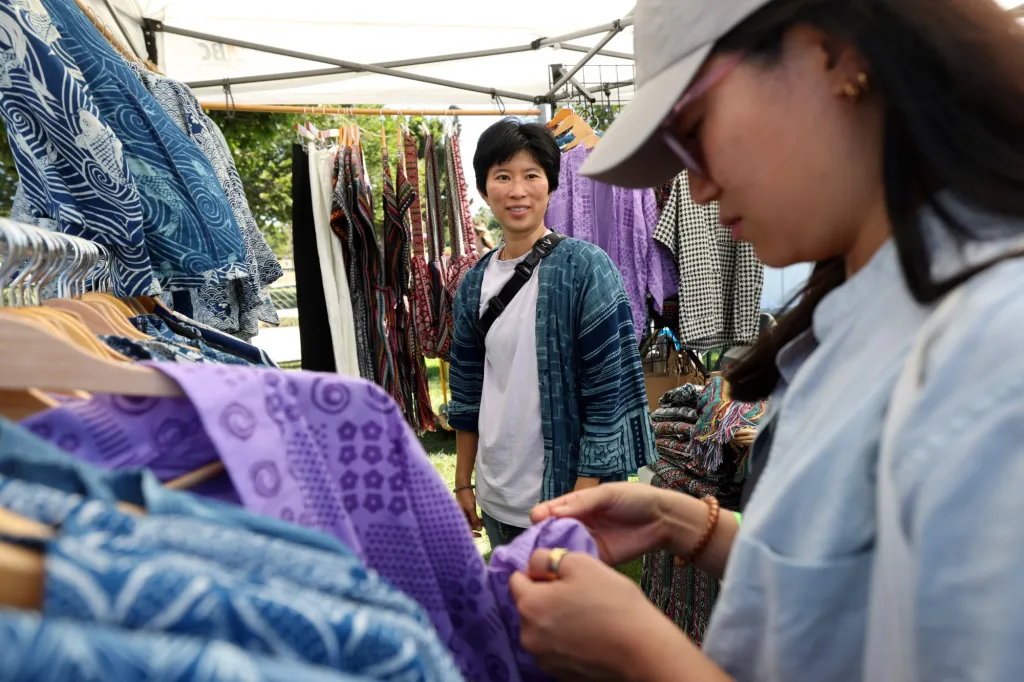Copyright San Diego Union-Tribune

Mim Na Chiangmai’s business selling jackets and kimonos survived the coronavirus pandemic and the following years of rising inflation. Tariffs are a new setback, but something she feels she can navigate. “I don’t feel like, ‘Oh my gosh, this is so heavy,’” she said. But it does feel tougher for smaller businesses than big ones, she added. “More than a massive, big scale (company) where you make a lot of money, I feel like us, me, it’s so delicate.” She was one of many merchants selling their wares recently at a San Diego Made Market. Many of their products, from ceramics to leather bags to beaded earrings, were crafted with materials sourced in San Diego County and as far as Thailand and Japan. They were doing so in a business environment newly shaped by import tariffs. The Supreme Court is expected to rule on the legality of these tariffs, announced by President Trump in the spring and applied over the course of the past months, in early November in a fast-tracked case that could entrench the changes or require billions in tariff revenue to be refunded. In San Diego, the way tariffs are impacting small businesses varies broadly, as a sample from that craft market and other local merchants illustrates. For those that source things domestically, it has been business as usual. Some merchants exposed to tariffs have raised prices. Some have tried to re-shore their suppliers or manufacturing but found local options lacking. One firm has decided to shut down. The administration also halted the de minimis rule, established in 1938, which had simplified imports by exempting small value shipments from duties and taxes. The threshold started at $1 and grew over time, changing from $200 to $800 in 2015. Now it is zero. This has especially hit businesses that imported smaller value shipments, exempting them from tariffs. For this and other reasons, some small businesses say they are hit more profoundly by the new tariff rules than larger ones, which have more power to negotiate deals with suppliers and shippers. Chris Cate, the president and CEO of the San Diego Regional Chamber of Commerce, said businesses of every size are “going to feel it to a degree,” but smaller companies are more exposed. “I don’t want to minimize the impacts of tariffs across all sizes of businesses,” Cate said. “But it is a reality that those businesses that have much larger purchasing power can spread costs over a broader customer base than your more niche, specialized businesses. … Small businesses are going to probably have a more difficult time to absorb or broaden the impact.” One challenge for small companies is discerning what each new tariff policy shift means for them. “The feedback we’ve been hearing is that … they don’t have the international policy experts that can help them navigate through an ever-changing landscape when it comes to international trade and policies. … Those are the types of struggles that we hear a lot about from our small business owners, that: What do we need to do? How do we comply?” Cate said. The cost of tariffs, though, is “probably one of the most concerning portions of this, especially for San Diego and us being a binational region that heavily relies on trade, especially with Mexico,” he said. For small businesses headquartered in San Diego with manufacturing in Mexico, “a huge concern is that we have products that are crisscrossing the border multiple times before they’re finished. And these are just added costs that are going to be passed on to consumers, especially when you have, form a California standpoint, over $30 billion in trade with Mexico. That’s a lot. They’re our No. 1 export market and they support thousands of jobs, and that’s a concern for us.” The Supreme Court’s anticipated ruling will bring some welcomed clarity, he added. “I think it will be somewhat settling for folks, but if it stands and we move forward on this, I think the larger concern is the policy implications of higher tariffs,” he said. Two clothiers: one raising prices, one shutting down Na Chiangmai’s business, Soulzential, sells jackets, kimonos and other items sourced and manufactured in Thailand. It is a family enterprise. Her mother slash business partner works in Thailand and employs a small team of seamstresses. In San Diego, Na Chiangmai does the design, marketing, strategy and sales. She watched as new tariff rates against Thailand wavered, from an initial 36% to 19%. For a box of about 60 garments, she was paying around $80 more in September. She passed this on to her customers to differing degrees. Some shirts cost $55, up from $50, and jackets could cost $75 or $80, up from $69. At the fair, garments hung on racks, available for any curious fingertips. They were soft and pliable, some with blue and white motifs that evoked fine porcelain or tile. It’s not like anything you’d find at Marshalls, Walmart or Macy’s. “My stuff is unique, and it brings diversity to the U.S,” she said. She explored manufacturing in L.A., but to make the same product in the U.S., she would have to charge $300 per jacket, she calculated. “It does not make sense. … Who’s going to (pay) that?” she asked. She hopes customers would pay $80. The wager: higher prices won’t drive away customers, because “if you go to a handmade event, you can pay that and … value that,” she said. The owners of a different textile-based business, Lynnerup Fine Shirts, have decided to shut down rather than raise prices. Dealing with the red tape around tariffs was too much work, said Rasmus Lynnerup, who founded the business with his wife Catherine in 2023. They tailored bespoke shirts, taking more than 40 measurements and assessing the customer’s posture for a perfect fit. Like Soulzential, this was a family enterprise, and slow fashion: handcrafted, natural fiber textiles, made to last. “At Lynnerup Fine Shirts, we use only the finest fabrics sourced from Europe, complemented by luxurious mother-of-pearl and shell buttons from the Pacific Ocean,” the website says. The shirts were priced from $400 to $700. But those far away fabrics and buttons became sharply more expensive due to tariffs. Rasmus Lynnerup’s button-up, draping his shoulders just so, would cost 39% more today, given the tariff rate on Switzerland. In August, he was planning to pivot from shirt manufacturing to management consulting, an earlier career. “I’m not sure that was their goal,” he said, , “but that is where that lands.” By October, he had ended his lease on factory space in Logan Heights. What if his shoppers, who have money to spare if they’re buying $400 shirts, would be willing to pay even more for a well-made shirt? All the import changes made running the shirt business not worth the trouble, he said. “It’s just a pain in the neck for me. … Now you have to fill in the cost of the (goods), and pay additional fees, and all of that stuff is just like — I don’t need to mess around with that,” he said. “It’s just an additional hassle.” He added he is fortunate, unlike other business owners, that he can easily shift directions due to his skills and professional experience. “I feel energized and excited,” he said. “I’m not down on it. In some ways, the tariffs and stuff coincided with what might have happened anyway. So I’m energized about my next chapter.” Sourcing domestically, or trying to The Julian Soap Company, whose shop on Main Street in Julian has been selling soaps and other fragrant goods since 1999, buys supplies from U.S. wholesalers, but some of those ingredients, which include Dead Sea mud, essential oils and silk, come from abroad. “I do not import any product directly from other countries,” Michaeline McConnell, the company’s founder, said in an email interview. Instead, she purchases from U.S. suppliers who import the raw materials. “Yes, raw materials prices have gone up from 30% to over 100%, especially essential oils. I have had to raise my prices on my soap around 10% in order to cover the jump in raw material prices. Shipping costs have increased also, so I look for shipping deals when I can.” Back at the maker market, a hat seller named Mike Bocek changed manufacturers after the tariffs kicked in, from a factory abroad to one in Southern California. He shopped around and found one affordable enough that he could keep his own prices stable. Vanida Clevenger, the owner of Cre8tive Studio, makes and sells cute decorative items, from cutting boards to water bottles to earrings. “I’ve always purchased locally or within the United States,” she said. “I like to support our country.” This set-up means she is not worried about tariffs as a small business owner. Rachael Fahlstrom, who launched Skin by Juniper and Jade this spring, tried to design a tariff-proof business, to the extent that she could. “When I was choosing my labs, I was really intentional, strategic, picking a lab that was U.S. based.,” she said. “There was a company in England that I was really interested in. But to get a sample — I think I ordered $100 worth of samples and it was almost $200 to ship it.” That included shipping tariffs and duty taxes. She also ruled out labs in China, where the tariffs would steeply raise the price. She found “an amazing lab” in Florida she is excited to work with. Labor costs are higher in the U.S., she said. But it was important to her to support U.S. businesses. Her serums and other skincare products had been exposed to tariffs with China, because she ordered bottles and boxes on Amazon Business. But the lab she chose also provides packaging. In a yarn shop, a tangle of tariffs Sara Heckman’s shop Apricot Yarn & Supply sells yarn from around the world. Her shop is experiencing a kaleidoscope of tariff rates. Uruguay’s Malabrigo Yarn is “made from luxurious natural fibers like merino wool, alpaca, and silk, known for their softness and comfort,” Apricot Yarn’s website says. Amano Yarn, based in Peru, is “known for its luxurious fibers sourced from the Peruvian Andes, including alpaca, wool, and pima cotton.” Rosa Pomar produces “hand-dyed yarns and textile products that highlight the rich textile heritage of Portugal.” She also sells handmade yarn from Bolivia. For Peru and Uruguay, the rates were 10% in September. Bolivia’s rate is 15%. For Portugal and must of the rest of the European Union, it is also 15%. Canada’s rate increased to 35% in August from 25%, though many goods, including some yarns, are exempt. “I understand that tariffs are ways that countries feel like they’re making things even,” Heckman said. “But people love finding something in our shop from Portugal that they wouldn’t be able to find anywhere else. … People really love that intimate experience of walking in a store and feeling all the yarn and finding what they like. And that’s they think that I don’t want to let go of. I don’t want to limit what we carry based on tariffs.” As a result of these tariffs, Heckman began to see some price increases from yarn suppliers starting in April. Others absorbed the costs. After August’s tariff rates went into effect, prices stayed the same, but suppliers charged a 10% duty fee or surcharge, she said. “We just pass it on to our customer,” Heckman said. Prices are at times as much as $2 more per skein of yarn, which is a steep hike, she added. “It feels like a big change, rather than a few cents to a dollar per piece,” she said. Her business is resilient and, in a sense, countercyclical. When the world is spinning out of control, yarn crafts feel like a way to hold things together. “I have to say that our business is still doing well,” she said. “It hasn’t affected us in the way that we’ve noticed that it’s reducing our business. I think, fortunately, for what we do, it’s a good escape from reality and the world. It gives you a sense of calm and you can use it to kind of take your mind away from all that news you see on your phone or your computer.” Still, like Na Chiangmai, she said small businesses are being hurt more by the Trump administration’s tariffs. “Unlike a large corporation that buys millions of dollars of product a year from these same sources, we can’t negotiate in the same way. We don’t have quite as much buying power,” she said. She also can’t find identical or very similar products made here. “Not everything is made here,” she said. The end of the de minimis rule has also caused instability and further price hikes, she added. In the past, she placed smaller orders from yarn suppliers in Canada, instead of ordering a lot at one time, aiming to keep the package value under $800. Now she pays a steep duty fee, passed along by shipping companies such as UPS and FedEx. This bill comes several weeks after the shipment arrives. “I don’t know what that bill is until I receive it. It could be $100. It could be $700. It’s adding that onto the product that I’ve already started selling, that wasn’t counting in that fee,” she said. These duty fees are not entirely new, she added, but they are more widespread and more unpredictable. While some shippers provide up front estimates, many do not. “We don’t know what it is. That’s the hardest part about it,” she said. These changes are leading her to become more selective in what she stocks, not fully cutting products, but ordering less of the brands knitters are not clamoring for. Running a business is about making a profit, but it’s also about building relationships with vendors and customers, she said. “It’s hard, because it’s not a choice I that made and it’s not a choice they made. It’s just this external force that’s creating a difficulty between our business relationship.” The uncertainty has been hard, even with suppliers being communicative and transparent. The regulation “changes, and then it changes again. It’s just very uncertain. So it’s hard to know what to do.” Even if she wanted to hedge by purchasing more yarn before the tariffs kicked in, she added, she could not. “We don’t have a giant amount of capital to throw in … ahead of time.” An even bigger doubt looms: “Is this going to continue? Are people going to shy away from extra purchases?” Crafting may be an escape, but it is discretionary. It’s not food or an electricity bill. “It’s a little bit on the scary side. In six months, is it still going to be going the way it’s going?”



